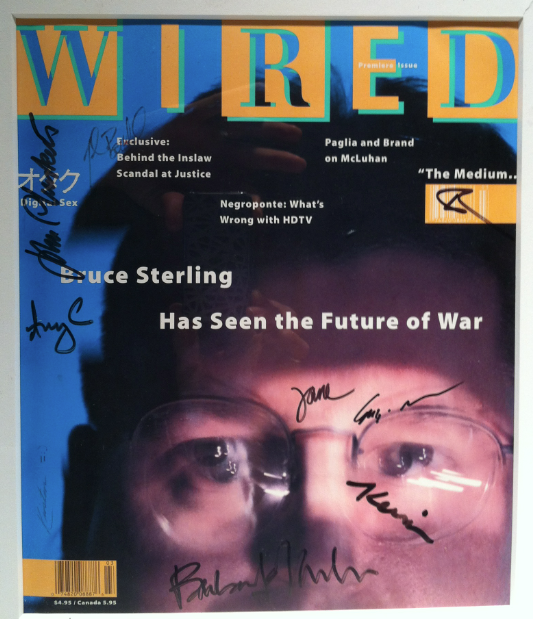The Future of War (From Jan., 1993 to the Present):

(image is a shot of my copy of the first Wired magazine, signed by our founding team)
I just read this NYT piece on the United States’ approach to unmanned warfare: Do Drones Undermine Democracy?. From it:
There is not a single new manned combat aircraft under research and development at any major Western aerospace company, and the Air Force is training more operators of unmanned aerial systems than fighter and bomber pilots combined. In 2011, unmanned systems carried out strikes from Afghanistan to Yemen. The most notable of these continuing operations is the not-so-covert war in Pakistan, where the United States has carried out more than 300 drone strikes since 2004.
Yet this operation has never been debated in Congress; more than seven years after it began, there has not even been a single vote for or against it. This campaign is not carried out by the Air Force; it is being conducted by the C.I.A. This shift affects everything from the strategy that guides it to the individuals who oversee it (civilian political appointees) and the lawyers who advise them (civilians rather than military officers).
It also affects how we and our politicians view such operations. President Obama’s decision to send a small, brave Navy Seal team into Pakistan for 40 minutes was described by one of his advisers as “the gutsiest call of any president in recent history.” Yet few even talk about the decision to carry out more than 300 drone strikes in the very same country.
Read the whole piece. Really, read it. If any article in the past year or so does a better job of displaying how what we’ve built with technology is changing the essence of our humanity, I’d like to read it.
For me, this was a pretty powerful reminder. Why? Because we put the very same idea on display as the very first cover story of Wired, nearly 20 years ago. Written by Bruce Sterling, whose star has only become brighter in the past two decades, it predicts the future of war with an eerie accuracy. In the article, Sterling describes “modern Nintendo training for modern Nintendo war.” Sure, if he was all seeing, he might have said Xbox, but still…here are some quotes from nearly 20 years ago:
The omniscient eye of computer surveillance can now dwell on the extremes of battle like a CAT scan detailing a tumor in a human skull. This is virtual reality as a new way of knowledge: a new and terrible kind of transcendent military power.
…(Military planners) want a pool of contractors and a hefty cadre of trained civilian talent that they can draw from at need. They want professional Simulation Battle Masters. Simulation system operators. Simulation site managers. Logisticians. Software maintenance people. Digital cartographers. CAD-CAM designers. Graphic designers.
(Ed: Like my son playing Call of Duty?)
And it wouldn’t break their hearts if the American entertainment industry picked up on their interactive simulation network technology, or if some smart civilian started adapting these open-architecture, virtual-reality network protocols that the military just developed. The cable TV industry, say. Or telephone companies running Distributed Simulation on fiber-to-the-curb. Or maybe some far-sighted commercial computer-networking service. It’s what the military likes to call the “purple dragon” angle. Distributed Simulation technology doesn’t have to stop at tanks and aircraft, you see. Why not simulate something swell and nifty for civilian Joe and Jane Sixpack and the kids? Why not purple dragons?
(Ed: Skyrim, anyone?!)
…Can governments really exercise national military power – kick ass, kill people – merely by using some big amps and some color monitors and some keyboards, and a bunch of other namby-pamby sci-fi “holodeck” stuff?
The answer is yes.
…Say you are in an army attempting to resist the United States. You have big tanks around you, and ferocious artillery, and a gun in your hands. And you are on the march.
Then high-explosive metal begins to rain upon you from a clear sky. Everything around you that emits heat, everything around you with an engine in it, begins to spontaneously and violently explode. You do not see the eyes that see you. You cannot know where the explosives are coming from: sky-colored Stealths invisible to radar, offshore naval batteries miles away, whip-fast and whip-smart subsonic cruise missiles, or rapid-fire rocket batteries on low-flying attack helicopters just below your horizon. It doesn’t matter which of these weapons is destroying your army – you don’t know, and you won’t be told, either. You will just watch your army explode.
Eventually, it will dawn on you that the only reason you, yourself, are still alive, still standing there unpierced and unlacerated, is because you are being deliberately spared. That is when you will decide to surrender. And you will surrender. After you give up, you might come within actual physical sight of an American soldier.
Eventually you will be allowed to go home. To your home town. Where the ligaments of your nation’s infrastructure have been severed with terrible precision. You will have no bridges, no telephones, no power plants, no street lights, no traffic lights, no working runways, no computer networks, and no defense ministry, of course. You have aroused the wrath of the United States. You will be taking ferries in the dark for a long time.
…Now imagine two armies, two strategically assisted, cyberspace-trained, post-industrial, panoptic ninja armies, going head-to-head. What on earth would that look like? A “conventional” war, a “non-nuclear” war, but a true War in the Age of Intelligent Machines, analyzed by nanoseconds to the last square micron.
Who would survive? And what would be left of them?
Who indeed.










